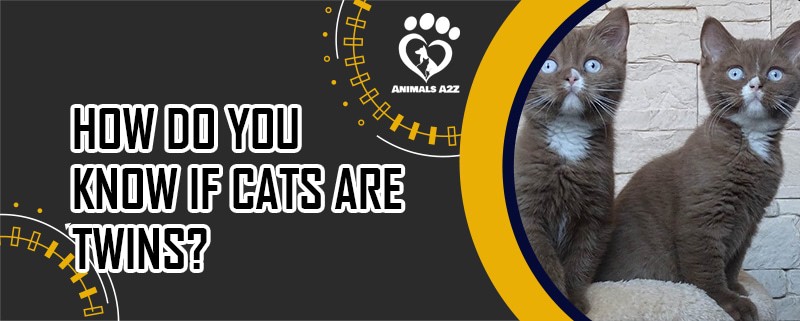Kittens can be twins. In fact, in many cat breeds, twin-sized litters are quite common. The most popular example is the Singapura breed. This feline produces around two to three kittens per litter, fewer than the average litter amount for all cat breeds.
Although having twins in a litter is more common in some breeds than others, any cat breed can have twins in their litter, including domestic short-haired and long-haired cats. Read on to find out if your cats are twins.
Table of Contents
Identifying if your cats are twins
Here’s how you can identify if your cats are twins:
Age of the mother cat
Smaller cat litters of one, two, or three kittens are more prevalent in younger (around a couple months to a year old) mother cats who have never bred previously. If the cat bears her first litter, the chances of her litter having twins is significantly higher.
Once a female cat gets older, her litter sizes can also become smaller. You can notice the difference once the mother cat reaches around six years old.
Breeding season
Certain times of the year can also affect the litter size of the mother cat. Although female cats can produce all year long, whether it’s cold or hot outdoors, they usually reach their peak mating season during spring and summer.
A cat’s litter tends to be larger during the summertime, so the chance of a mother cat bearing twins during these months is higher than the other times of the year.
Genetics of cat siblings
Cat littermates or siblings are genetically diverse in general. Even if these cats are of the same litter, they can actually have different cat fathers, a heteropaternal superfecundation phenomenon. This means that even if these cats share the same parents, they will inherit random gene combinations. Making them genetically unique from their siblings.
Identical twins
Kittens can become twins due to occupying their mother cat’s womb simultaneously, but they can also become identical, meaning both cats came from one sperm and one egg. If the two kittens have that in common, you can consider them ‘identical twins’ rather than your usual litter-mate siblings. Like any other cat, they’re all their own individuals, but they’re masters at being in sync.
Identical cats are felines that come from the same egg fertilized by a single sperm. This can happen when that fertilized egg divides early in the development stage, resulting in two different lineages of cells that ultimately form the cats. When this situation occurs, the two identical felines will carry the same genetic information.
However, unlike identical human twins, identifying two kittens can be challenging since their color pattern genes can get expressed differently in two felines even when their genes are identical.
Unless two felines are confirmed identical twins, which you can’t determine based on their appearance alone, the DNA test results of two kitten litter-mates are guaranteed to be different. While these siblings can have a specific amount of DNA in common, the combination of all the possible gene variations produced by the mother cat and tom cat will be unique for each offspring.
So, if you really want to know if your cats are identical twins, the only way to be sure is through a cat DNA test.
Why are cats of the same litter genetically diverse?
It’s a common notion that kittens from the same cat parents will share 50 percent of DNA from their father and the other 50 percent from their mother cat. But the truth is that these kittens can inherit many different combinations of their cat parents’ DNA.
The thing is, kittens are just like human babies. They carry two copies of each gene from their parents. So, it’s true that they will receive 50 percent of DNA from their mom and 50 percent from their dad. But the kittens will receive a completely random variation of traits from their parents.
Common questions about twin cats
Are animals from the same litter twins?
Twins are the two offspring produced by a single pregnancy, and they can be either identical or fraternal. Identical twins mean that the offspring develop from one egg (monozygotic). Meanwhile, fraternal twins mean they come from two different eggs (dizygotic) by the same pregnancy. So, technically all cat litters that have more than one kitten are fraternal.
Do twin kittens share a placenta?
Usually, each kitten will have her own placenta. After a cat gives birth to her kittens, she will also deliver each placenta. The number of placentas present must be equal to the number of kittens born.
That’s why if you notice there are fewer placentas than there are kittens, it means either the mother could have eaten the placenta, or she gave birth to identical twins who shared a placenta.
Can cats have twins in a litter?
Yes, but it’s rare for cats to give birth to identical kittens, and it’s also challenging to determine if kittens are identical twins. That’s because when kittens look the same, it should mean they share the same mother and father. This can be rare unless you have a female and male cat at home. Plus, kittens in the same litter can be half-siblings as their mother may mate with more than one male cat.
Are all cats twins?
All cats are generally twins, fraternal twins to be specific. Fraternal twins are kittens that came from different eggs and were fertilized by different sperm. But these fraternal twins are just technically littermates with the same mother. They are not actual identical twins unless they came from one egg and one sperm; these twins are called identical twins which are from monozygotic eggs.
Identifying your twin cats
Identifying if cats are twin is not an easy job. But the pointers mentioned above will help you with knowing whether your cats are twins. If a young mother cat gave birth, her kittens will more likely be twins.
And if the kittens were born by a mother cat that has been impregnated during winter or another season other than summer, then there’s a high chance that kittens are twins. Kittens can also be twins if the breeding occurred in a controlled environment or with human intervention.
Some identical twin cats have various interesting characteristics. Some of them are look-a-likes and can mirror themselves, while some look very different from each other. The best way to identify if cats are twins is by having them genetically tested by the experts.


